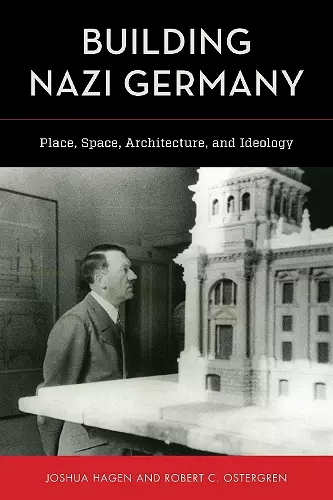Building Nazi Germany
Place, Space, Architecture, and Ideology
Joshua Hagen author Robert C Ostergren author
Format:Paperback
Publisher:Bloomsbury Publishing PLC
Published:16th Nov '21
Currently unavailable, and unfortunately no date known when it will be back
This paperback is available in another edition too:
- Hardback£105.30was £117.00(9780742567979)

This richly illustrated book details the wide-ranging construction and urban planning projects launched across Germany after the Nazi Party seized power. Hagen and Ostergren show that it was far more than just an architectural and stylistic enterprise. Instead, it was a series of interrelated programs intended to thoroughly reorganize Germany’s economic, cultural, and political landscapes. The authors trace the specific roles of its component parts—the monumental redevelopment and cleansing of cities; the construction of new civic landscapes for educational, athletic, and leisure pursuits; the improvement of transportation, industrial, and military infrastructures; and the creation of networked landscapes of fear, slave labor, and genocide. Through distinctive examples, the book draws out the ways in which combinations of place, space, and architecture were utilized as a cumulative means of undergirding the regime and its ambitions. The authors consider how these reshaped spaces were actually experienced and perceived by ordinary Germans, and in some cases the world at large, as the regime intentionally built a new Nazi Germany.
Th is book will be a useful reference guide for teachers and students, and given the extensive bibliography and footnotes, a departure point for further research. While Nazism had its singular aspects, comprehensive syntheses like Building Nazi Germany are effective at showing important continuities and discontinuities through time and space. * Historical Geography *
There is a substantial scholarly literature concerning architecture in the Third Reich, but Hagen and Ostergren break new ground. While dealing—as other scholars have—with the relationship between the construction of public buildings and Nazi aesthetics, Hagen and Ostergren go a step further by placing their study in a broad context. They approach their subject from the point of view of geographers, seeking to understand the relationship among aesthetics, ideology, utility, and urban planning during the Third Reich. Of particular interest is the chapter on the construction of concentration camps. In their epilogue, "The Building and Breaking of Nazi Germany," the authors provide a brief but valuable analysis of the destruction of Germany’s urban landscape during the final days of WW II; there is also interesting discussion of the use of Nazi buildings during the postwar period. These are subjects usually ignored by other scholars. The numerous illustrations enhance the utility of this book. Building Nazi Germany makes an important contribution to understanding of National Socialism.
Summing Up: Highly recommended. Graduate students, researchers, faculty.
An indispensable work for anyone interested in urban planning and architecture under National Socialism. Erudite, captivating, and filled with fascinating photos and maps, the book leaves the reader with a comprehensive understanding of the multifaceted and often contradictory imprint of Nazi ideology on the built landscape of Germany. -- Guntram H. Herb, Middlebury College
Nazi Germany may be best remembered for the unparalleled, global destruction wrought by its toxic racism and war machinery. But, as Hagen and Ostergren demonstrate in this fascinating book, the regime’s totalitarian ideology extended to the built world, too. Their valuable research shows the stunning and frightening extent of the Nazi regime’s architectural megalomania. -- Steven Hoelscher, University of Texas at Austin
The surfeit of "destructive creation" that shaped so many of the projects carried out in interwar Italy was also at play in the case of the other major fascist regime of the time, National Socialist Germany. Building Nazi Germany, a meticulously researched and admirably comprehensive monograph co-authored by Joshua Hagen and Robert C. Ostergren, extends the analytical focus in order to capture, beyond iconic architectural and planning projects, the production of the full range of spaces where the Third Reich would be forged, performed, experienced, and celebrated. Each chapter sheds light on a specific sphere of activity: capital cities (of the state, the party, the movement), urban settlements of diverse scales, housing settlements and units, athletic complexes, engineering projects and infrastructures, military complexes, in the end even labor and extermination camps. Destruction as an act of cleansing and regenerating cities, bodies, and the Volk as a whole is far from absent in the book's core narrative: the Nazi regime used demolition and invasive remodeling both as a technique of embellishing the heritage of the past and as a blunt instrument of healing "sick" cities and bodies. Yet Hagen and Ostergren's book begins and ends by underlining the constructive trope-the "imperative to build * Journal of Urban History *
The book's cover displays a familiar image of the Nazi era: Adolf Hitler carefully inspects a grandiose architectural model. And yet, Building Nazi Germany contains much more than first meets the eye, for the book incorporates over 130 images of diverse government construction projects ranging from the monumental to the mundane. These photographs, maps, and illustrations reflect the book's broad coverage as well as its scholarly contribution. Joshua Hagen and Robert Ostergren explore the immediately recognizable elements of Nazi architecture, but they also disrupt this iconography by offering a more comprehensive visualization of the regime's building efforts. Ultimately, the authors show how projects differed in substance, scale, and level of completion yet were nevertheless connected in unexpected ways. * Central European History *
ISBN: 9781538158333
Dimensions: 218mm x 154mm x 32mm
Weight: 798g
510 pages